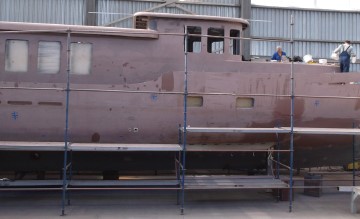In marine paint systems, such as commercial ship paints, paints of fishing boats and paints of pleasure yachts, filler applications have a very important place.
Epoxy based putty systems, which are generally preferred in modern marine paint systems, have the important tasks of leveling the surface and increasing the resistance of the surface to water, moisture and other atmospheric conditions.
Given the difficult conditions of the marine or freshwater environment in which they are used, the relevant epoxy-based fillers must have superior properties.
Points to Consider During the Application of Putties
There are some important points that should be considered during the application of epoxy based putty systems. First of all, epoxy putties should definitely not be applied on raw-bare surfaces. There must be a primer or undercoat paint product on the substrate. It is also necessary to sand before the application of the putty.
In a multi-step application, the surface must be sanded between the putty coats. Teknomarin branded and all other high-quality brand epoxy putties do not contain solvents; therefore, they only adhere to the surfaces already sanded.
After the application of the putty, the putty covered surface should be painted with a suitable undercoat or primer and should not be left unprotected.
Due to the filler pigments in the content, epoxy putties form a microporous structure after drying, and the surfaces that are not protected with a suitable undercoat tend to absorb moisture and other contaminants. It is necessary to heat the environment and dry the surface for a while after the sanding process.
Epoxy putties need moderate temperature at the curing-curing stage, like all other epoxy-based coatings and coatings.
Particularly at temperatures below 10°C, the putty drying time and sanding time is very long. If possible, it is necessary to normalize the drying behavior of the putty by increasing the temperature of the application environment to at least 25- 30°C during and after the epoxy putty application, especially in winter conditions.
Epoxy putties must be exposed to temperatures above 50°C to reach their final hardness. It is necessary to keep epoxy putty applied surfaces at 50-70°C for a certain period of time if possible; in order to minimize surface settlements due to complete drying and shrinkage behavior after application.
Since the epoxy putties exposed to such temperatures will be fully dry and the surface will be settled, the surface settlements that will take place after the paint process will be kept to a minimum.
Epoxy – based putties are two-component products and the A and B parts of the product must be mixed very well and at the specified mixing ratio in order to obtain the best performance.
In epoxy-based putties, the colors of A and B parts are usually designed differently. After mixing the parts A and B before use, it is necessary to mix thoroughly until the color becomes completely homogeneous.
If different colors and color shades are observed in the mixture, mixing should continue until the color is homogeneous. Mixing ratios of parts A and B of epoxy putty should be done as specified in product label. The use of hardener (B) more than or less than specified will cause the mixture to remain wet and sticky.
When mixing parts A and B, care must be taken to mix the amount needed for the application. After mixing parts A and B, the pot life of the mixture is 20- 60 min. depending on the formulation of the putty and the ambient temperature. Excessive amount of mixtures become unusable after the pot life is over.
Features of High Quality Epoxy Pastes
With the increasing preference of dark colors on yachts and increase in the length of the yachts produced and the use of more curved shapes in the body forms of yachts, the choice of putty has become more important.
Quality putty brands are trying to adapt their products according to today’s demanding market conditions. Nevertheless, even in large projects where the products of world-famous brands are used, problems such as cracking-breaking-collapsing- shrinkage in putties can be seen and hardly compensated damages can occur.
Extremely thick putty applications, excessive tensile-stretching on yacht surfaces, changes in raw material resources, time pressure in yacht building processes, and even changing climatic conditions have led to many problems. In this case, the yacht manufacturers are in a continuous search for the best putty systems,
If we list required properties in quality epoxy pastes:
1-Flexibility,
2-Easy application,
3-Easy sanding,
4-Long pot life,
5-Fast drying and fast sanding,
6-Easy mixing ratio and easy mixing,
7-Low density.
Of course, in order to design a commercially meaningful product, it is necessary to put low cost of production and therefore low-price criterion next to these properties.
As can be seen in terms of putty brands, it is very difficult to provide all these conditions at a high rate and it can be possible with experience with an important knowledge.

Caner Masmanacı
Marketing Manager
Teknomarin





